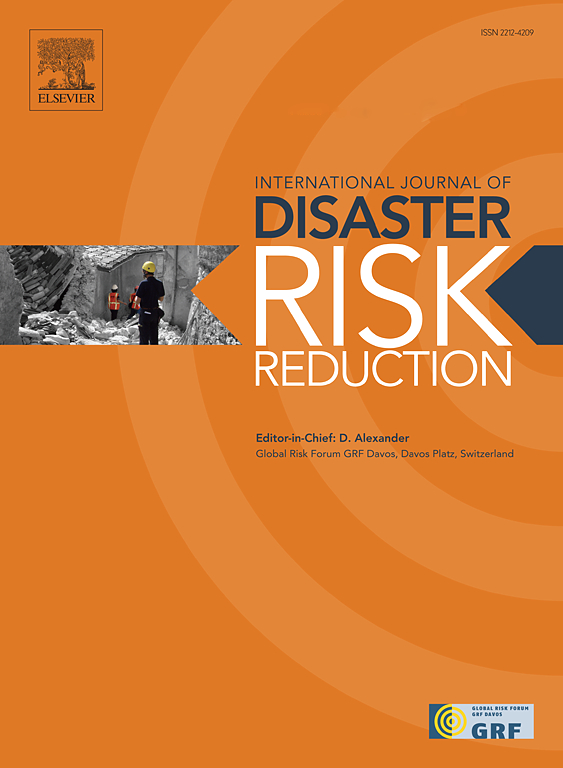Evaluating flood early warning system and public preparedness and knowledge in urban and semi-urban areas of Johor, Malaysia: Challenges and opportunities
IF 4.5
1区 地球科学
Q1 GEOSCIENCES, MULTIDISCIPLINARY
International journal of disaster risk reduction
Pub Date : 2024-09-28
DOI:10.1016/j.ijdrr.2024.104870
引用次数: 0
Abstract
Flood Early Warning System (FEWS) play a crucial role in mitigating the impacts of floods by providing timely information to the public, which is particularly important for flood-prone areas in the Malaysian State of Johor that have suffer significant damages and disruptions almost every year. This research presents an assessment into the current state of FEWS through expert interviews and consultations with the concerned department to understand the management and institutional status and challenges in employing FEWS. In addition, a total of 106 structured questionnaires were administered as part of the survey research to a sample of residents in urban Johor Bahru and semi-urban Kota Tinggi, two regions vulnerable to floods, to collect data on their level of preparedness and knowledge, and their perceived effectiveness of FEWS. The analysis revealed that 69.8 % of the respondents did not have any knowledge on the FEWS in their place, and 60.5 % respondents turn to social media to gain information on flood warning, occurrence and forecast. This study also evaluates the opportunity for the messaging application as an additional support system for FEWS. The research highlights and identifies the challenges and barriers to accessing and utilising FEWS. The study calls for the incorporation of messaging application, preferable WhatsApp to transmit early warnings to the end-users and to use their feedback in designing/redesigning the FEWS. The findings can inform policy and decision-making processes aimed at improving flood preparedness and response strategies, and contribute to the existing literature on FEWS in Malaysia and other similar regions.
评估马来西亚柔佛州城市和半城市地区的洪水预警系统及公众准备情况和知识:挑战与机遇
洪水预警系统(FEWS)通过向公众提供及时的信息,在减轻洪水影响方面发挥着至关重要的作用,这对于马来西亚柔佛州的洪水易发地区尤为重要,因为该地区几乎每年都会遭受重大损失和破坏。本研究通过专家访谈和咨询相关部门的方式,对 FEWS 的现状进行了评估,以了解 FEWS 的管理和机构现状,以及在应用 FEWS 方面所面临的挑战。此外,作为调查研究的一部分,本研究还对新山市区和哥打丁宜半市区这两个易受洪水侵袭地区的居民进行了抽样调查,共发放了 106 份结构化问卷,以收集他们对 FEWS 的准备程度、知识水平和感知效果的数据。分析结果显示,69.8% 的受访者对其所在地区的 FEWS 一无所知,60.5% 的受访者通过社交媒体获取有关洪水预警、发生和预报的信息。本研究还评估了信息应用作为 FEWS 附加支持系统的机会。研究强调并确定了获取和利用 FEWS 所面临的挑战和障碍。研究呼吁采用信息应用程序(最好是 WhatsApp)向最终用户发送预警,并在设计/重新设计预警系统时利用他们的反馈。研究结果可为旨在改进洪水防备和应对策略的政策和决策过程提供信息,并为马来西亚和其他类似地区有关预警系统的现有文献做出贡献。
本文章由计算机程序翻译,如有差异,请以英文原文为准。
求助全文
约1分钟内获得全文
求助全文
来源期刊

International journal of disaster risk reduction
GEOSCIENCES, MULTIDISCIPLINARYMETEOROLOGY-METEOROLOGY & ATMOSPHERIC SCIENCES
CiteScore
8.70
自引率
18.00%
发文量
688
审稿时长
79 days
期刊介绍:
The International Journal of Disaster Risk Reduction (IJDRR) is the journal for researchers, policymakers and practitioners across diverse disciplines: earth sciences and their implications; environmental sciences; engineering; urban studies; geography; and the social sciences. IJDRR publishes fundamental and applied research, critical reviews, policy papers and case studies with a particular focus on multi-disciplinary research that aims to reduce the impact of natural, technological, social and intentional disasters. IJDRR stimulates exchange of ideas and knowledge transfer on disaster research, mitigation, adaptation, prevention and risk reduction at all geographical scales: local, national and international.
Key topics:-
-multifaceted disaster and cascading disasters
-the development of disaster risk reduction strategies and techniques
-discussion and development of effective warning and educational systems for risk management at all levels
-disasters associated with climate change
-vulnerability analysis and vulnerability trends
-emerging risks
-resilience against disasters.
The journal particularly encourages papers that approach risk from a multi-disciplinary perspective.
 求助内容:
求助内容: 应助结果提醒方式:
应助结果提醒方式:


